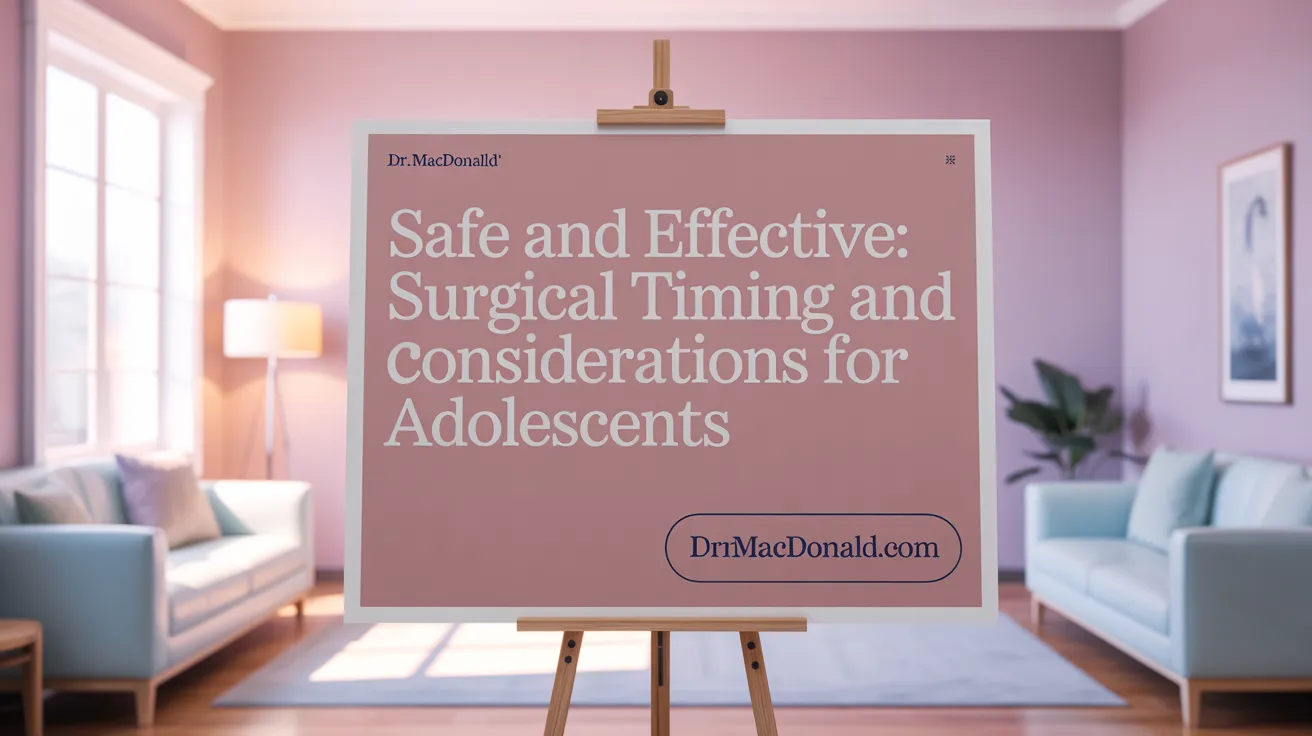Understanding Teenage Rhinoplasty
Rhinoplasty, commonly known as a nose job, ranks among the most requested cosmetic procedures for teenagers seeking to enhance facial appearance or correct functional nasal issues. Determining the right age for surgery involves balancing physical development with emotional readiness to ensure safe and satisfying outcomes. As adolescents and their families explore this decision, a clear understanding of when and why rhinoplasty is appropriate is essential.
Physical Maturity and Nasal Growth: Foundation for Timing

How does nasal growth affect the timing of rhinoplasty in teenagers?
Nasal growth plays a crucial role in deciding the appropriate timing for rhinoplasty in teenagers. The nose continues to develop during adolescence, with nasal maturity typically reached between ages 15 and 17. Performing surgery before the nose has fully stopped growing can interfere with normal facial development, potentially causing deformities or asymmetries that might require revision surgery.
Surgeons usually recommend waiting until facial bones and nasal structures are mature enough, which is generally around age 15-16 for girls and 16-18 for boys. This timing helps ensure that the results of the surgery are stable and that the natural growth process does not compromise the aesthetic or functional outcome.
The assessment of physical growth completion involves more than just chronological age. One effective method is checking if the teenager’s feet have stopped growing for at least a year, since foot growth cessation often correlates with skeletal maturity.
Understanding gender differences in growth is also important. Girls typically reach facial maturity earlier than boys—around age 14-15—while boys may continue developing until age 16-18. Therefore, the timing for rhinoplasty is often adjusted based on these differences to optimize results and safety.
Prior to surgery, a thorough physical examination is performed to evaluate craniofacial structures and confirm growth cessation. This assessment, combined with patient maturity and expectations, helps determine the best window for safe and effective rhinoplasty.
In summary, waiting until nasal and facial growth is completed is essential to ensure that the surgery results are natural, sustainable, and free from developmental complications. Careful planning and evaluation help achieve the best aesthetic and functional outcomes for teenage patients.
Emotional Readiness and Psychological Considerations

What physical and emotional maturity considerations should be taken into account before a teenager undergoes nose surgery?
Deciding on rhinoplasty for a teenager involves careful evaluation of both physical and emotional factors. Physically, it is crucial that the nose has fully stopped growing to avoid future deformities or the need for additional procedures. Typically, nasal growth concludes around ages 15-16 for girls and 16-17 for boys. Surgeons carefully assess facial development to ensure the bones and cartilage have matured.
Emotionally, readiness is equally important. Teenagers should demonstrate a clear understanding of what the surgery entails, along with realistic expectations for the results. It is vital that the decision comes from their own motivation and not external pressures like peers or family influence.
A teenager should show emotional stability, resilience, and patience throughout the process. Support from parents or guardians also plays a crucial role in decision-making and recovery. Many surgeons recommend a consultation where both physical facial maturity and emotional maturity are reviewed. This comprehensive assessment helps ensure that the teen is prepared for the surgery physically and psychologically.
Ultimately, both considerations are fundamental for achieving safe, natural, and satisfying outcomes. Prioritizing these factors minimizes risks and enhances overall satisfaction with the results, fostering confidence and well-being in young individuals.
Medical Justifications and Functional Benefits for Teens
What are common medical justifications for rhinoplasty in teenagers?
Rhinoplasty in teenagers is often performed for medical reasons rather than purely cosmetic concerns. One of the primary motivations is to correct structural issues that impair normal nasal function. These include a deviated septum, which can obstruct airflow and cause difficulty breathing. Enlarged turbinates and adenoids, which can block nasal passages, are also common issues addressed during surgery.
Congenital anomalies such as cleft lip and palate or craniosynostosis may necessitate rhinoplasty to improve both function and appearance. Trauma-related deformities, like nasal fractures or cartilage displacement, are another common indication; repairing these injuries restores proper airway function and corrects aesthetic concerns.
Addressing these problems is crucial not only for breathing but also for healthy growth and development. Unresolved functional issues can inhibit normal craniofacial development by causing ongoing nasal obstruction or asymmetry.
Some cases involve correcting deformities linked to developmental issues or injury that lead to nasal obstruction or recurrent sinus infections. Surgery may help prevent secondary problems, such as sinusitis or breathing difficulties, that could affect overall health.
In summary, the main goal of medically justified rhinoplasty in teenagers is to improve nasal airflow, ensure safe growth, and repair deformities caused by trauma or congenital factors. When performed under appropriate conditions and with careful assessment of growth potential, it safely enhances both function and facial harmony.
Age Guidelines and Optimal Timing for Teenage Rhinoplasty

At what age is it appropriate for a teenager to undergo rhinoplasty?
Deciding when a teenager can have rhinoplasty largely depends on the completion of the nose's growth. Typically, facial development finishes around ages 15-16 for females and ages 16-17 for males. Surgeons usually recommend waiting until this growth phase is complete to avoid disrupting nasal or facial development.
Assessment methods include observing if the teen’s foot growth has stabilized over a year, which correlates with the end of craniofacial growth. Physical examinations and sometimes imaging help confirm maturing facial bones. Emotional maturity and understanding of the procedure are equally important, ensuring the teenager has realistic expectations.
It's crucial to involve parents in decision-making and obtain appropriate consent. Each case is unique, and timing should be tailored to individual development and health status.
What are typical age ranges and optimal timing for teenage nose surgery?
Generally, the ideal age for teenage rhinoplasty falls between 15 and 18 years. Girls often are ready around ages 15-16, while boys are more suitable around ages 17-18, contingent on when their nasal growth ceases. Most medical guidelines suggest waiting until age 15-16 for females and 16-17 for males, aligning with when facial bones have fully matured.
This timing helps ensure stable and lasting results, reducing the risk of future deformities caused by ongoing growth. For severe deformities, functional breathing issues, or psychological impacts, some surgeons might consider earlier intervention, but such cases require careful evaluation.
Parental involvement is necessary for those under 18, and scheduling the surgery during school holidays can facilitate smoother recovery. Overall, the decision should prioritize physical maturity, emotional readiness, and individual circumstance.
| Aspect | Typical Age Range | Rationale | Additional Notes |
|---|---|---|---|
| Facial Growth Completion | 15-16 years | Growth of nasal bones usually finishes during this period | Assessed via foot growth and physical exams |
| Gender Variations | Girls: 15-16; Boys: 16-17 | Girls tend to develop earlier, allowing earlier surgery | Individual growth patterns vary |
| Psychological Readiness | Any age within the range | Emotional maturity ensures realistic expectations | Surgeon evaluations and psychological assessments |
Safety Considerations and Surgical Techniques for Teen Rhinoplasty

When is rhinoplasty safe and appropriate during adolescence?
Rhinoplasty can be safe and effective during adolescence once the nose has reached sufficient growth, which is typically around ages 15-16 for girls and 17-18 for boys. Most studies and expert opinions indicate that performing septorhinoplasty at this stage does not interfere with ongoing facial growth. It is crucial that the teenager demonstrates emotional maturity and has realistic expectations about the outcome.
Before surgery, careful medical and psychological evaluations are performed. Surgeons assess whether the adolescent’s facial bones have fully developed, often using physical examinations and growth indicators such as foot development. Parental consent is necessary, and involvement in decision-making ensures emotional readiness.
Timing is highly individualized. Surgery before complete nasal growth can lead to unpredictable results or the need for revision procedures. Therefore, a comprehensive assessment by a qualified surgeon is essential to determine the ideal timing.
Postoperative support and follow-up care are vital for ensuring safety and a positive outcome. With proper timing and preparation, adolescents can benefit from rhinoplasty to improve nasal function, appearance, and self-esteem, with minimal risk of affecting facial development.
Guidance for Teens and Parents: Making the Decision for Rhinoplasty
Deciding when a teenager should undergo rhinoplasty involves careful consideration of several important factors. First and foremost, physical maturity is crucial. Most facial growth, including the nose, typically concludes between ages 14 and 16 for girls and 16 to 18 for boys. Surgeons recommend waiting until this growth phase is complete to avoid deformities or the need for revision surgery. An effective way to assess growth completion is to observe if the feet have stopped growing for at least a year, as this usually correlates with facial development.
The consultation process begins with a thorough evaluation by an experienced facial plastic surgeon. During this appointment, the surgeon will assess the teen’s facial maturity, discuss their goals, and evaluate their overall health. Emotional readiness is equally important, as realistic expectations and a mature mindset help ensure satisfaction with the results.
Parental consent is legally required for individuals under 18. Parents and guardians must support and understand the procedure's risks, benefits, and possible outcomes. Involving family in the decision encourages emotional stability and ensures adequate support throughout the process.
Factors influencing the decision include the teen’s reasons for wanting rhinoplasty, such as correcting nasal deformities from genetics, trauma, or congenital issues. For teenagers with functional problems, like breathing difficulties, surgery may be recommended earlier. For purely aesthetic reasons, surgeons often advise waiting until full facial maturity to maximize natural results.
Psychological support and counseling are recommended components of the decision-making process. Surgeons, including some like Dr. Miller, may collaborate with mental health professionals to evaluate whether the teen is psychologically prepared for surgery. This step helps address any underlying self-esteem issues and promotes healthy expectations.
Ultimately, the decision should balance safety, facial harmony, and the teen's well-being. Non-invasive alternatives, such as dermal fillers, can be considered for those who are not yet ready for surgery. The guiding principle is to prioritize the teen's health and happiness, ensuring that the timing and intention behind the procedure are suitable for their unique development and goals.
Final Thoughts on Teenage Rhinoplasty Timing
Choosing to undergo rhinoplasty as a teenager involves a careful balance of physical development, emotional readiness, and medical considerations. Ensuring that nasal growth is complete, typically by mid to late teenage years, reduces risks and supports lasting results. Equally crucial is the teen's psychological maturity and realistic understanding of the procedure, aided by professional consultation and parental support. With appropriate timing and expert surgical care, rhinoplasty can effectively address both aesthetic and functional nasal concerns, enhancing confidence and quality of life for teens. Families contemplating this journey should prioritize safety, patience, and comprehensive guidance to achieve natural, harmonious outcomes.
References
- At What Age Can You Have a Rhinoplasty?
- What Is the Best Age for a Nose Job?
- Ideal, Average, and Recommended Age for Rhinoplasty
- Rhinoplasty at Every Age: How Nose Jobs Differ at 16 and 61
- Age Restrictions: How Old You Have to Be for Rhinoplasty
- Teenage Rhinoplasty, Nose Jobs & Nose Surgery
- Teen Rhinoplasty Expert Care at Aesthetic Surgical Images
- Dallas TX Teen Rhinoplasty | Irving Adolescent Nose Job ...
